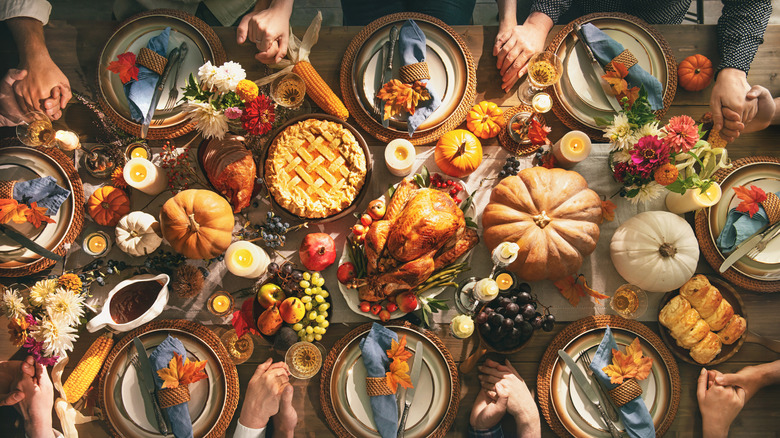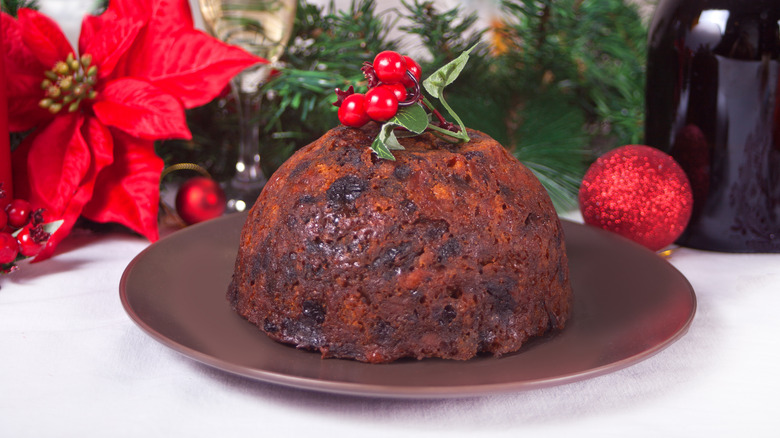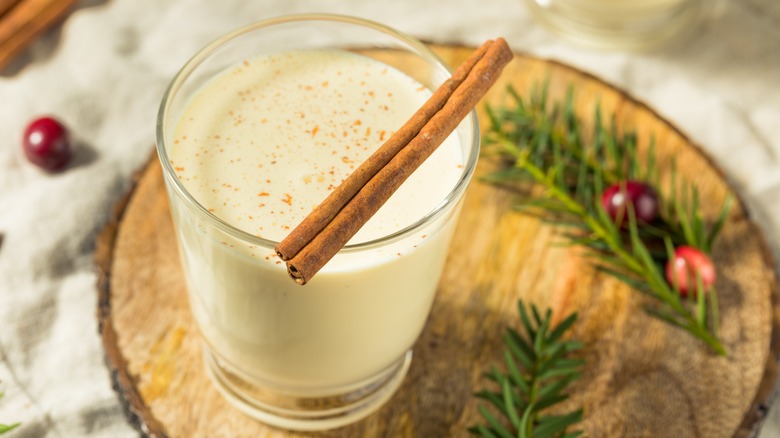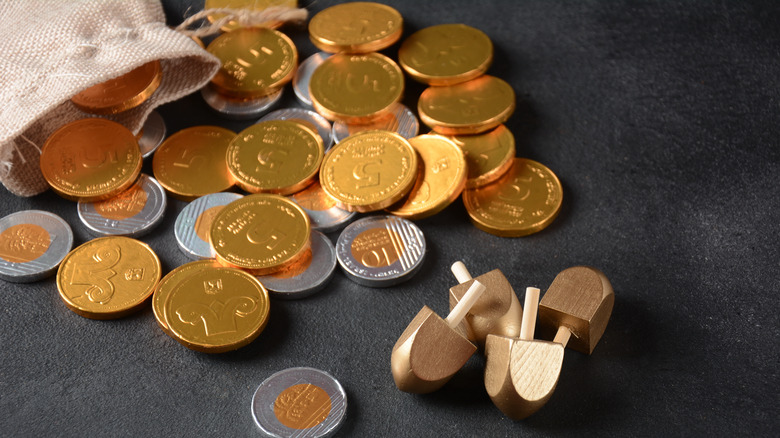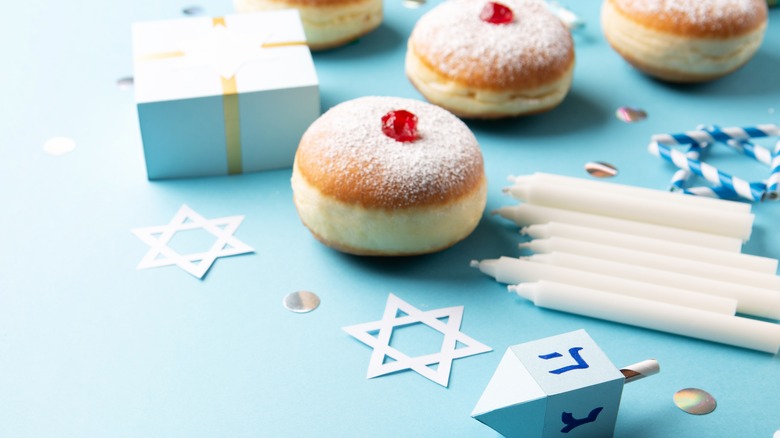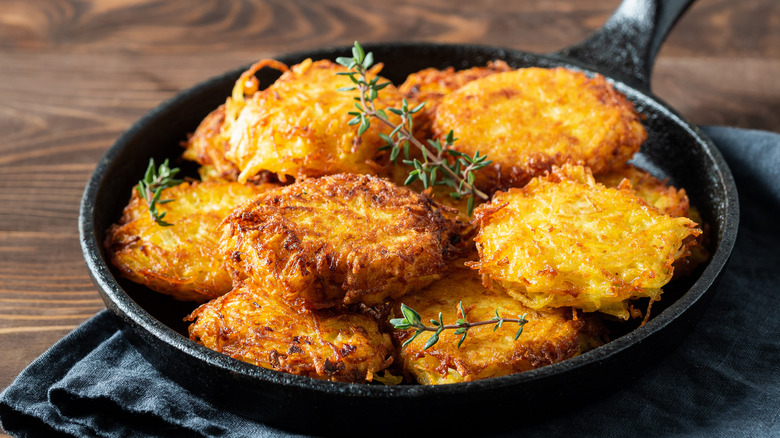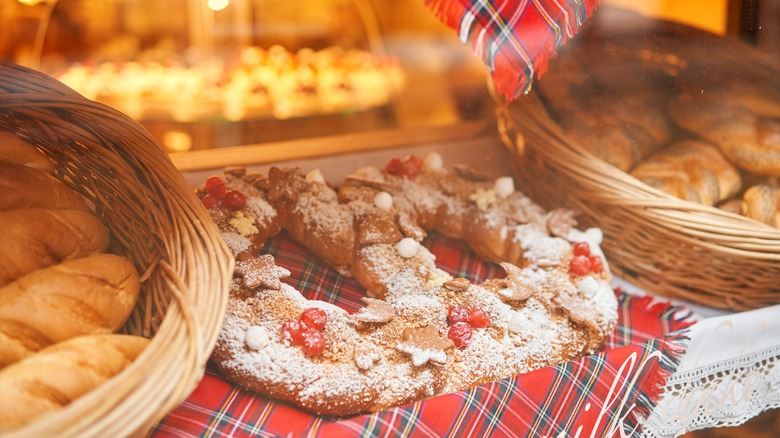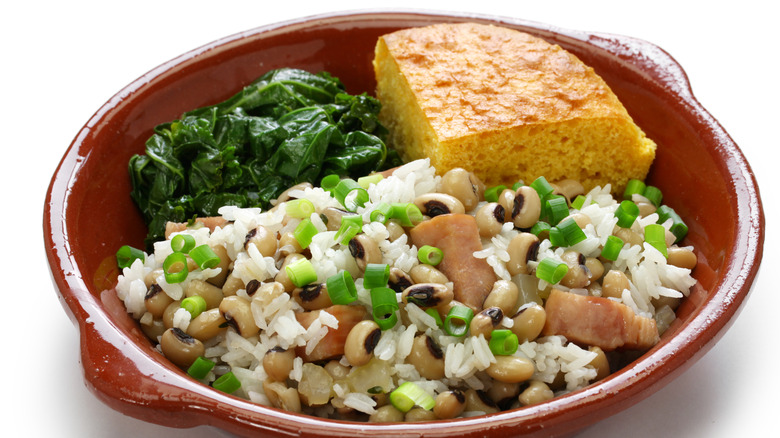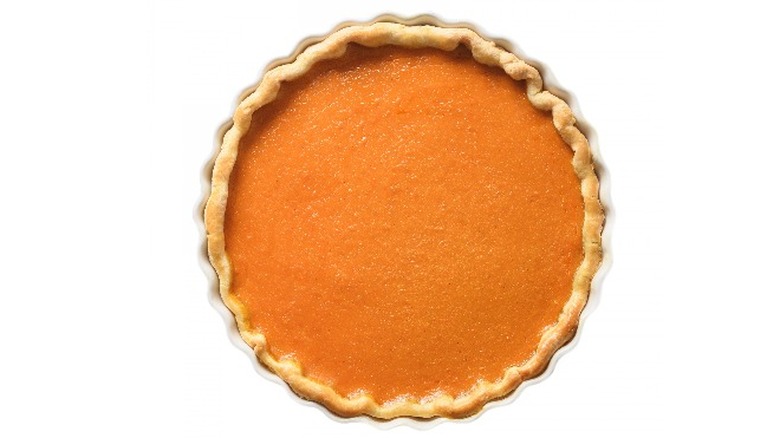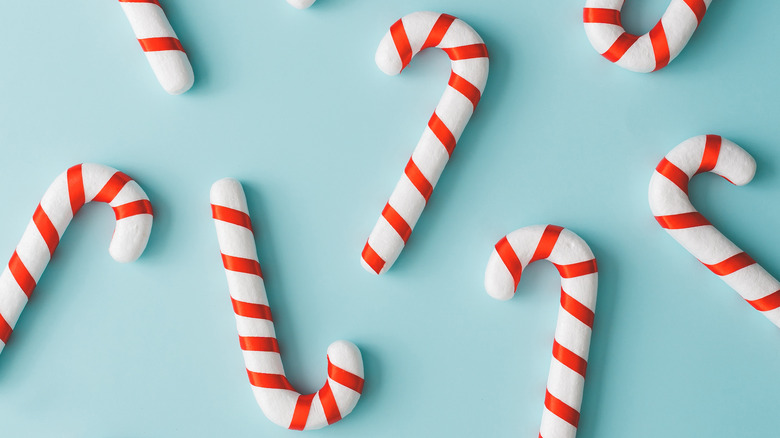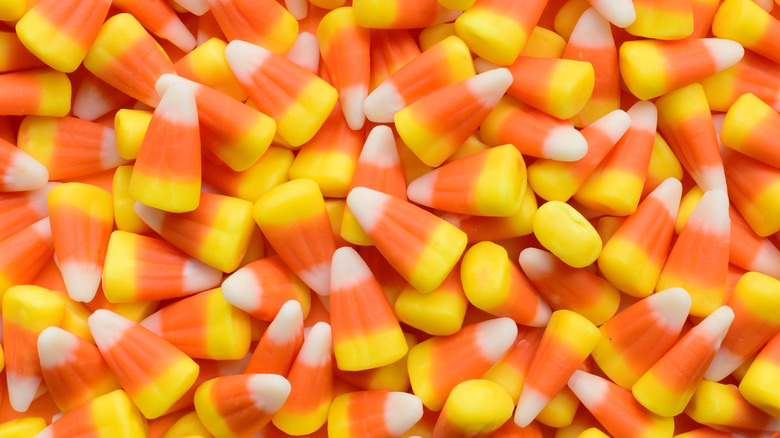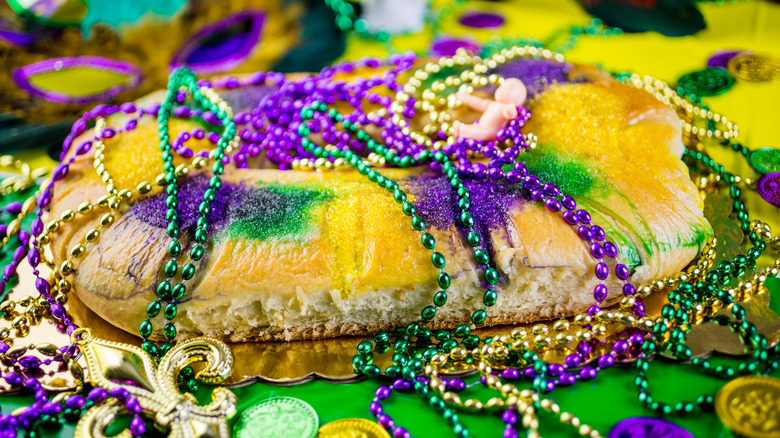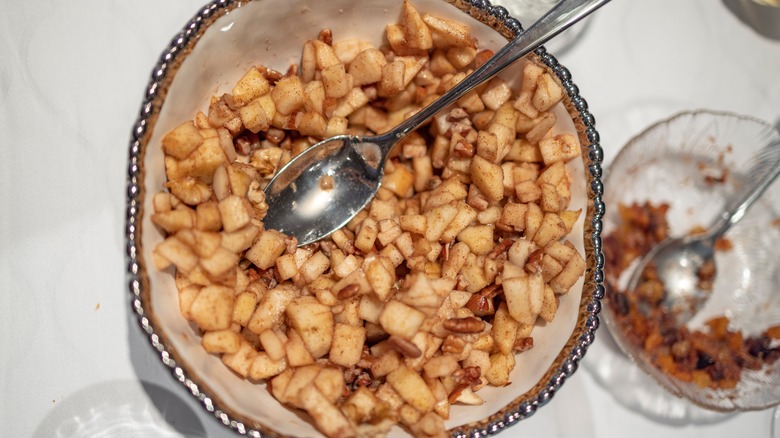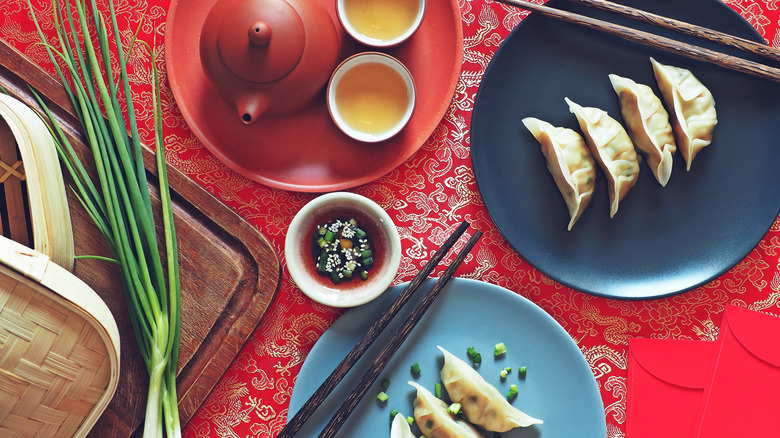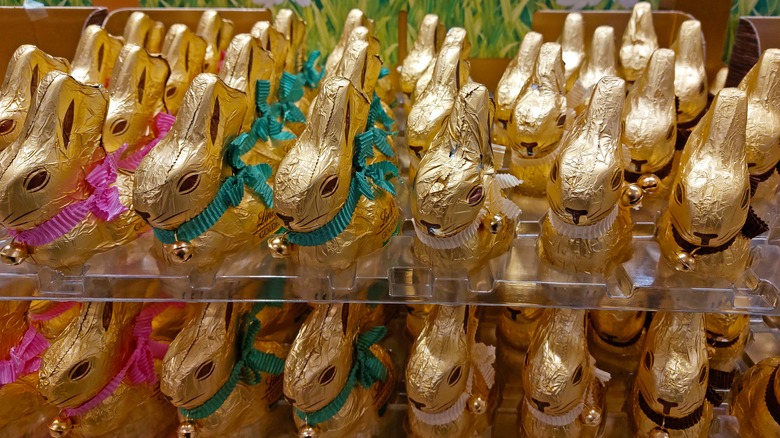The Brief Histories Of 15 Iconic Holiday Foods
We all know the best part of any holiday is the food. Every year people gather in kitchens, dining rooms, and around trays of food to take in traditional holiday fare. We do not make and eat holiday foods just because they are delicious, though many are. We do it as a tradition. We do it as a way to connect with those we love. Food has a way of connecting us to culture and narrative.
It is nearly impossible to think of a holiday that does not have a certain food connected to it. While they can vary by region or religion, they remain iconic to their celebrants. With all the importance of food, many of us may stop and wonder how certain foods became attached to our holiday traditions. Here, we look at 15 classic holiday foods and bring you a brief history of how they came to be.
1. Figgy pudding
As the classic Christmas song "We Wish You a Merry Christmas" says, "Bring us some figgy pudding." We know the song, but many on this side of the pond don't know what figgy pudding is, let alone why it is included in one of our favorite holiday songs. Figgy pudding, also known as plum or Christmas pudding, is a British Christmas tradition. It is not a pudding in the American sense but a steamed cake filled with dried fruit and alcohol. To make matters slightly more confusing, it does not necessarily contain figs or plums, instead getting its name from the Victorian use of the term "plum" to mean dried fruit in general.
History Today notes that plum pudding dates back to at least the 1400s. Back then, sweet meat pies and pottages were used as a way of preserving meat. With a healthy dose of both sugar and alcohol, they were naturally used for preservation and became a staple celebration food. Over time, meat was dropped from the equation in favor of dried fruits. By the 1800s, celebration puddings took on their traditional round shape and were associated with Christmas, showing up in Victorian Christmas portraits and in Charles Dickens's "A Christmas Carol," and taking on the moniker "Christmas pudding." Traditional recipes now include 13 ingredients — representing Jesus and the 12 apostles — and are decorated with a sprig of holly for the crown of thorns.
2. Gingerbread
What Christmas would be complete without gingerbread cookies? The history of gingerbread dates back to 2400 B.C. when the first recipe for gingerbread was recorded in Greece (via PBS). Ginger is a root from China that became widely traded around world. Chinese recipes for gingerbread can be found dating back to the 10th century. By the 11th century, cakes with similar ingredients to modern-day gingerbread were being made in Europe, per Martha Stewart. Over time, a hard cookie version became popular in Europe and was widely available at fairs. Queen Elizabeth I liked the gingerbread cookies and is cited as the person who started the tradition of decorating the cookies to look like people (via PBS). It is thought that gingerbread cookies for Christmas may have first started as a way to symbolize baby Jesus (via Martha Stewart).
Gingerbread houses began appearing in Germany in the 16th century but became more popular due to the Grimm's retelling of the "Hansel and Gretel," fairytale, which features a gingerbread house. The houses then became a popular Christmas decoration for the German immigrant population in Pennsylvania.
3. Eggnog
Creamy Christmas beverages can be found worldwide, from the Puerto Rican coconut-based coquito to egg- and milk-based eggnog. The origins of eggnog are unclear. However, early Medieval Britain had what is thought to be a precursor to the drink with an eggnog-like drink called "posset," which was a warm milk and ale drink (via Time). Eggs and milk were considered rich people's foods and may have been enjoyed in the winter by the wealthy British.
The name, too, is under debate. The "egg" part comes from one of the primary ingredients, but "nog" could refer to anything from "grog," an alcoholic beverage, or "noggin," a wooden cup. Either way, by the 1700s, colonizers brought warm drinks to America and began adding alcohol to them — typically rum, which was readily available. The drink evolved from a general wintertime drink to a specifically Christmas drink. And by the 1800s, eggnog became responsible for starting a drunken Christmas riot at West Point University, per Smithsonian Magazine. By the mid-1960s, non-alcoholic eggnog came on the market, and eggnog sales in America have only continued to rise over the past half-century (via Forbes).
4. Gelt
Gelt is chocolate coins made for Hanukkah. Traditionally, gelt is given during the holiday and is often used for betting while playing dreidel (via Learn Religions). According to Reform Judaism, gelt is reminiscent of the money distributed by the Maccabees after the Second Temple's rededication. The design is meant to replicate the Jewish coins minted during the time of the Maccabees.
Money, in general, has been associated with the holiday for centuries. Originally, real coins were given to religious school teachers and then eventually to children. They were used as a way to teach children about giving (via Learn Religion). In the 1920s, despite being a minor Jewish holiday, Hanukkah began to gain in popularity. According to Smithsonian Magazine, it was seen as a winter holiday counterpart to Christmas in its commercialized potential. As a result, candy companies started making chocolate Maccabee soldiers, latkes, and coins. While the first two did not take off, gelt has been a part of American Hanukkah tradition ever since.
5. Sufganiyot
It doesn't get much better than doughnuts for the holidays. From Polish pączki for Fat Tuesday to Berliners for New Year's in Germany to the classic Hanukkah sufganiyot — a jelly-filled doughnut, doughnuts basically rule as holiday treats. But you may be wondering how they became associated with holidays. For sufganiyot, doughnuts are a natural extension of the Hanukkah story.
As part of the celebration of the rededication of the Second Temple thanks to the Maccabees, Hanukkah celebrates the miracle of the oil used to light the menorah — while the oil should have only lasted one night, it lasted eight nights. Oil is an integral part of the Hanukkah story. However, as Time magazine points out, doughnuts were not part of the diet at the time of Hanukkah. Instead, the tradition of donuts started with North African Jews who ate fried dough balls for the holiday.
Centuries later in Europe, the sugar trade allowed the fried dough to transform from a savory treat filled with meat to a sweet one filled with jam. When Jews fled to Isreal to escape anti-Semitism, both African and European groups brought doughnut love with them.
However, what sealed the deal for sufganiyot was the Histadrut, a trade group trying to create skilled jobs in the area (via Jewish Virtual Library). Since jelly doughnuts are more challenging to make at home than other Hanukkah foods, they promoted them to create jobs. It was incredibly successful, and now sufganiyot is part of the Hanukkah tradition.
6. Latkes
Potatoes are amazing, and fried potatoes are near perfection. Luckily, at Hanukkah, fried potatoes are a quintessential part of the holiday festivities. However, these pancakes didn't start out as potatoes at all but instead as cheese.
Cheese enters the tale, according to Reform Judaism, as a way to symbolize not the story of Judah Maccabee but that of Judith. Judith protected her people by taking General Holofernes for a picnic with cheese and wine, eventually killing him. Some translations have her carrying cheese or cheese pancakes. Due to some tenuous connections between the two stories during the Middle Ages and a migration of Italian Jews bringing ricotta pancake recipes with them, 14th-century Jews began celebrating the holiday with cheese pancakes (via PBS).
Potatoes were introduced to Europe 200 years later (via Reform Judaism), but it took until the 18th and 19th centuries for potatoes to replace cheese. According to Bustle, this happened due to crop failures in Poland and Ukraine. Potatoes were planted instead, and due to their ease and availability, potato pancakes became traditional.
7. New Year's pretzel
The New Year's pretzel is a regional tradition that finds its roots in Germany. In the 17th century, German children wore pretzel necklaces on New Year to bring luck in the coming year. Since then, the tradition has evolved to eat not just any pretzel on New Year, but large soft pretzels typically finished with sweet toppings such as glaze. Lora Wiley-Lennartz notes in her food blog that she was first introduced to them by her German mother-in-law. She points out that in Germany, they are eaten either at midnight on New Year's Eve or for breakfast on New Year's Day.
The New Year's Pretzel is not just a German food anymore. During the 20th century, the tradition became popular in parts of the country with large German immigrant populations, such as Sandusky, Ohio, and Pittsburgh, Pennsylvania. The pretzels are supposed to bring luck and a sweet new year.
8. Hoppin' John
New Year's' is a time to look for good luck, and in the southern United States, that means eating Hoppin' John. Hoppin' John is a dish made from black-eyed peas, rice, and pork. While we don't know the exact history, according to History, Hoppin' John was likely created by enslaved Africans in the Carolinas. Black-eyed peas are an African crop, and rice was often grown on slave plantations. The first recipe was found in the 1840s, but a similar dish was likely made on South Carolina plantations before that.
The dish is supposed to bring luck in the new year, with each ingredient being symbolic. The black-eyed peas represent coins; the pork represents the cheap meat available to enslaved people; the collard greens, which they are served with, represent money; and the cornbread, also traditionally served with it, represents gold. Today, it is traditional to add extra pork or a penny underneath to boost luck.
9. Pumpkin pie
A whopping 87% of all pie consumed in the United States is consumed between Thanksgiving and Christmas, with nearly half of all pie consumed during the year being eaten on Thanksgiving (via The Sentinel-Record). With those numbers, it is not surprising that pumpkin pie has become so synonymous with Thanksgiving. But it begs the question: Why pumpkin?
Pumpkins originated in central America (via History). By the mid-1500s, squash was taken and grown in Europe, where it began to be used in cooking. While pumpkins were almost certainly around for the first Thanksgiving, they likely did not appear on the table as a modern-day pumpkin pie.
Over the years, pumpkin pie recipes have taken many forms, from a stewed pumpkin pie with almonds in 1650s France to a sliced pumpkin pie mixed with savory herbs or dried fruits in 1670s England. But finally, in 1796, "American Cookery," by Amelia Simmons, published a recipe for pumpkin pie that greatly resembles the one on today's tables.
After the recipe was published, pumpkin pie began to gain popularity during Thanksgiving and was included in the 1827 novel "Northwood" as part of a Thanksgiving celebration (via NHPR). The pie has only grown in popularity, and it is hard to imagine the holidays without it.
10. Candy canes
Christmas would not be complete without the bicolored, hook-shaped candy cane. But, while these candies are now quintessential parts of the holiday, their history is marked by speculation.
The most common theory of the candy cane's origin, is that a choirmaster in 1670s Germany gave an all-white straight version out to his choir boys to keep them quiet during services. When the church complained, he bent their original stick shape to represent a staff. Another myth is that the hook shape represents the letter "J" for Jesus, per History. Still, a third says that the hook was added so the candy could be used to decorate a Christmas tree. While we may not know for sure, it is likely the candy was German in origin.
In 1847, August Imgard, a German immigrant to America, decorated a Christmas tree with white candy canes (via Candy History), which sparked their popularity in America. In the 19th century, the color red and the peppermint flavor were both added to the mix, creating the confection we know and love today.
11. Candy Corn
Candy corn is one derisive Halloween treat. Perhaps some of the unpleasant feelings towards the candy come from the fact it wasn't initially created to taste good but to look good and appeal to children.
According to History, in the late 1800s, molded mallow creme candy was made and marketed to children. These candies were produced year-round. As a way to utilize and showcase the then innovative technique of triple layering colors, George Renninger created candy corn. Originally, the candy was marketed as "chicken feed" as Americans did not consider corn to be food for humans.
In the 20th century, candy corn was typically sold in bulk to children. While originally candy corn was found year-round, as candy became more popular for Halloween in the 1950s, candy companies specifically advertised it as a Halloween candy. While it can still be found throughout the year, it remains most popular at the end of October.
12. King cake
King cake, which can also be called Twelfth Night cake, is used to celebrate Mardi Gras and is most prevalent in New Orleans, Louisiana. According to the Southern Food and Beverage Museum, precursors to the cake can be found as early as Medieval Europe when sweets were eaten on Epiphany through Mardi Gras. The day could also be called "King's Day" (via New Orleans' Showcase).
King cake became a New Orleans tradition on January 6th, 1870. A group known as the Twelfth Night Revelers paraded through the town. They served fake cakes, each of which contained a bean. Whoever found the gold bean was crowned queen (via the Southern Food and Beverage Museum). The tradition spread, and real cakes began to be used with either a bean or a small plastic or porcelain baby inside.
King cakes are traditionally cinnamon yeast cakes decorated with three colors symbolizing the three wise men, as well as purple for justice, green for faith, and gold for power (via Randazzo King Cakes).
13. Charoset
Charoset is one of the traditional foods on the Seder plate for Passover. However, despite being a food most people cannot go without on the holiday, it is one of the only items not explicitly mentioned in the Torah or in the prayer book for Passover, the Haggadah (via Jewish Magazine). It is first mentioned in the Jewish text Mishna, hundreds of years later, as part of a debate about whether it must be eaten at Seder or not (via Reform Judaism). No conclusion is reached in the text.
Despite this, charoset has become a food to start the Seder. Typically eaten with matzah, the dish symbolizes the clay the enslaved Israelites were forced to build with and the apple trees, "which, according to the midrash, the Israelite women seduced their husbands" beneath (via Forward). The mixture is usually made of ground fruit, spices, and nuts but can vary in texture and ingredients across the world. Ashkenazi charoset, for example, typically uses chopped apples mixed with fruit and nuts, whereas one Italian charoset can utilize pears and is cooked. Another uses chestnuts and is ground to a fine paste (via the Jewish Museum of Maryland).
14. Lunar New Year's dumpling
The connections between dumplings and Lunar New Year date back 1,800 years during the Han Dynasty. The legend tells of a Doctor named Zhang Zhongjing who was treating an epidemic of frostbite on the villagers' ears, creating spiced meat dumplings and feeding them to the sick (via the BBC). The people recovered well. He is said to have handed them out between Solstice and New Year, which is why they are still eaten today as part of the celebration.
There are many kinds of dumplings. The dumplings made for New Year's are jiaozi, which the BBC states means transitioning from old to new, which deepens its New Year's connection. China Educational Tour notes that the original name was 'jiao'er, which was a reference to their ear-like shape, whereas BBC says the name jiaozi references the shape of money in ancient China. Either way, dumplings are still eaten on Lunar New Year as a way to bring good luck in the coming year.
15. Chocolate Bunnies
What do chocolate and bunnies have to do with the resurrection of Jesus? Bunnies, in general, do not have any direct relation to Easter. There is some thought that the bunny started as just a general symbol of spring and rebirth, per Readers Digest. However, the first "Easter bunny" dates back to at least the 1700s in German folklore, where an egg-laying bunny brought colored eggs to children (via History).
Eventually, the custom developed to include baskets of treats. This all came to a head in 1890 when Robert L. Strohecker created a 5-foot-tall chocolate easter bunny (via Slate). Strohecker is now remembered as "the father of chocolate Easter bunny." Then in the early 1900s, the Bortz Chocolate Company in Reading, Pennsylvania, began mass-producing chocolate Easter bunnies. Now it is practically impossible to imagine the holiday without chocolate bunnies, and companies such as R.M Palmer West Reading, Pennsylvania, make over 25 million of them each year (via Smithsonian Magazine).
